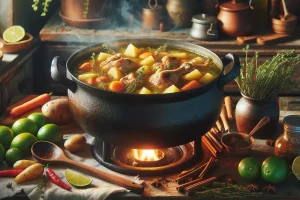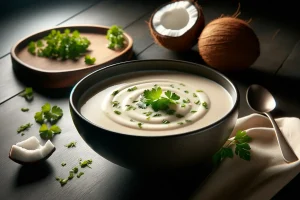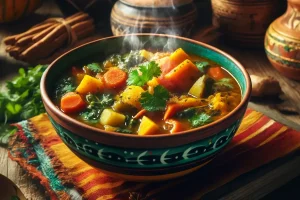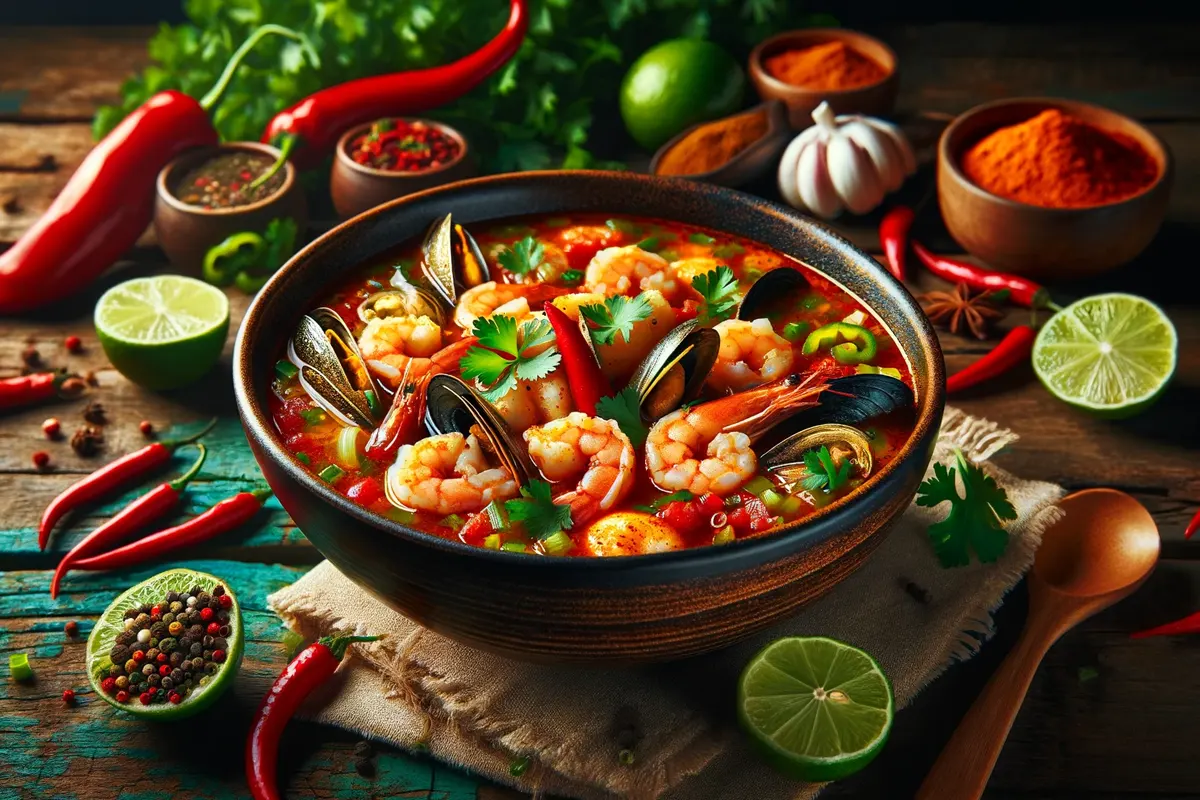Embarking on a culinary journey through the Caribbean islands reveals a vibrant tapestry of flavors, colors, and traditions that tantalize the taste buds and warm the soul. At the heart of this gastronomic adventure lies the Caribbean soup, a dish as diverse and eclectic as the islands themselves. From the spicy kick of a Jamaican Pepper Pot to the comforting embrace of a Trinbagonian Corn Soup, these soups are more than just meals; they are a celebration of Caribbean culture, heritage, and the unifying power of good food. This article peels back the layers of this beloved dish, exploring its rich history, varied recipes, and the ingredients that make it so special. So, grab a spoon, and let’s dive into the warm, welcoming waters of Caribbean cuisine.
Introduction to Caribbean Soup
Introduction to Caribbean Cuisine
Caribbean cuisine is a fusion of African, European, Indian, and indigenous flavors, creating a unique and irresistible blend that reflects the region’s complex history and cultural diversity. The culinary landscape is as varied as the islands themselves, each adding its own spice to the mix. From the hearty stews of Jamaica to the seafood delights of the Bahamas, the Caribbean offers a dish for every palate.
The Essence of Caribbean Soup
At its core, Caribbean soup embodies the spirit of the islands. It’s not just food; it’s comfort in a bowl, bringing warmth and joy with every spoonful. Whether it’s the fiery heat of a spicy soup or the creamy richness of a coconut milk-based concoction, these soups are renowned for their bold flavors and nutritious ingredients. They’re a testament to the Caribbean’s ability to turn simple, fresh produce into something truly extraordinary.
But, how do you thicken Caribbean soup, you might wonder? The answer lies in the ingenious use of natural thickeners found in the region, such as okra, split peas, and even breadfruit, which lend a delightful texture to the soup without overpowering its vibrant flavors.
In the following sections, we’ll uncover the secrets behind the most popular Caribbean soups, delve into the essential ingredients that give them their characteristic zest, and explore the variations that keep this culinary tradition alive and kicking. So, stay tuned, as we bring the taste of the Caribbean to your kitchen.
Popular Caribbean Soup Recipes
The Caribbean Sea, a vast expanse of azure waters, is home to a myriad of islands each boasting its own unique culinary traditions. Among these, soups stand out for their heartwarming and soul-nourishing qualities. Let’s embark on a gastronomic tour of the Caribbean by exploring some of the most beloved soup recipes that have become synonymous with comfort and conviviality in this part of the world.
Chicken Souse: A Classic Caribbean Soup
First up on our culinary expedition is the Chicken Souse, a dish that captures the essence of Caribbean flavors with its simple yet tantalizing ingredients. Imagine a broth infused with the zesty tang of fresh lime juice, the aromatic warmth of allspice, and the comforting richness of tender chicken, all mingling together to create a symphony of flavors. This soup isn’t just a treat for the taste buds; it’s a warm hug in a bowl, perfect for those lazy weekend afternoons or as a remedy for the rainy day blues.
The beauty of Chicken Souse lies in its simplicity and the ease with which it can be tailored to individual tastes. Whether you like it a bit spicier, with a kick of scotch bonnet pepper, or prefer a milder version, this soup is as versatile as it is delicious. And if you’re wondering about the secrets to its rich flavor, look no further than the traditional marination process, where the chicken is bathed in spices and lime juice, allowing the flavors to penetrate deep into the meat, ensuring every bite is infused with the vibrant tastes of the Caribbean.

Exploring Other Caribbean Soups
But why stop at Chicken Souse when the Caribbean offers a cornucopia of soups, each with its own story and flavor profile? Take the Jamaican Pepper Pot, a soup that is as hearty as it is historic. This dish, with its base of callaloo (a leafy green similar to spinach) and an assortment of meats, is a testament to the island’s ability to turn simple ingredients into culinary masterpieces.
Then there’s the Callaloo Soup, a staple in Trinidad and Tobago, which showcases the versatility of the callaloo leaf. Blended with coconut milk, okra, and crab, this soup is a creamy, dreamy concoction that brings the tropical flavors of the islands straight to your dining table.
And we mustn’t forget the Fish Tea, a light broth that belies its depth of flavor. Originating from the shores of Jamaica, this soup, with its delicate blend of fresh fish, herbs, and spices, is the Caribbean’s answer to the classic bouillabaisse.
As we savor the rich tapestry of soups that the Caribbean has to offer, it’s clear that these dishes are more than just meals; they’re a celebration of the islands’ culinary diversity and a reflection of their vibrant cultures. So, whether you’re a seasoned soup aficionado or a curious culinary explorer, there’s a Caribbean soup waiting to transport you to the sun-soaked beaches and bustling markets of this enchanting region.
Stay tuned as we delve deeper into the heart of Caribbean cuisine, uncovering the ingredients and techniques that make these soups the soulful dishes they are.
Ingredients and Cooking Techniques
Diving into the heart of Caribbean culinary traditions, we uncover a treasure trove of vibrant ingredients and age-old cooking techniques that breathe life into the region’s iconic soups. Each ingredient, chosen for its freshness and flavor, plays a pivotal role in crafting soups that are not just meals but a celebration of Caribbean heritage.
Key Ingredients in Caribbean Soup
The soul of Caribbean soup lies in its ingredients, a colorful palette of local produce and spices that infuse each dish with the essence of the islands. Coconut milk, with its creamy texture and subtle sweetness, often serves as a velvety base, adding a layer of richness that is unmistakably Caribbean. Then there’s the allspice, known as the “Jamaica pepper,” whose warm, aromatic notes lend a depth of flavor that is both complex and comforting.
Vegetables like okra and yams, staples in the Caribbean diet, add body and texture to the soups, transforming them into hearty, nourishing meals. The fiery kick of Scotch bonnet peppers introduces a spicy element, balancing the richness with a heat that tingles the palate. Meanwhile, the tang of lime juice cuts through, adding a bright note that elevates the overall flavor profile.
Herbs such as thyme and cilantro are used liberally, their fragrant leaves infusing the broths with a freshness that complements the robust flavors. And let’s not forget the seafood and meats, from succulent crab to tender chicken, which provide a satisfying richness and depth that anchor these soups in the realm of comfort food.
Traditional Cooking Techniques
The magic of Caribbean soups extends beyond their ingredients to the traditional techniques passed down through generations. Slow cooking is a hallmark of many recipes, allowing flavors to meld and deepen over time, resulting in dishes that are rich in taste and steeped in tradition. The use of a “dutch pot” or heavy-bottomed pot, for instance, distributes heat evenly, ensuring that the soup simmers to perfection.
Marination plays a crucial role, especially in meat-based soups like Chicken Souse, where ingredients are often left to soak in a blend of spices and citrus juices. This not only tenderizes the meat but also infuses it with an array of flavors that are quintessentially Caribbean.
The art of layering flavors is another technique that defines Caribbean cooking. Starting with a base of sautéed onions and garlic, chefs build complexity by adding spices, followed by main ingredients like meats and vegetables, allowing each layer to contribute its unique notes to the final dish.
In the Caribbean, cooking is as much about technique as it is about the ingredients. It’s a dance of flavors and textures, a symphony of tastes that come together to create soups that are not just food but a celebration of life and culture. As we explore these traditional methods and the ingredients that make Caribbean soups so distinctive, we gain a deeper appreciation for the culinary heritage that has shaped these islands for centuries.
Stay tuned as we continue our journey through the flavors of the Caribbean, exploring the health benefits and the comforting power of these beloved soups.
Health Benefits and Nutritional Value
As we delve into the heartwarming world of Caribbean soup, it’s not just the tantalizing flavors and rich heritage that capture our attention. These soups are also a wellspring of health benefits, embodying the Caribbean’s natural approach to wellness through food. Laden with fresh vegetables, lean proteins, and aromatic herbs and spices, each bowl is a testament to the region’s ethos of nourishing the body and soul.
Nutritional Benefits of Caribbean Soup
The cornerstone of Caribbean soups is their use of fresh, locally-sourced ingredients, each bringing a host of nutritional benefits to the table. Take, for instance, the vibrant array of vegetables like okra, pumpkin, and sweet potatoes that are staples in many recipes. These are not just color and texture; they’re packed with essential vitamins, minerals, and fiber, supporting everything from digestive health to immune function.
Lean proteins, whether it’s the tender chicken in a Chicken Souse or the fresh catch in a Fish Tea, provide a hearty dose of high-quality protein essential for muscle repair and growth. But the nutritional magic doesn’t stop there; many Caribbean soups are simmered with bones and seafood shells, creating a broth rich in collagen and minerals like calcium and phosphorus, which are crucial for bone health and joint function.
The liberal use of herbs and spices, from thyme to allspice, does more than just flavor these dishes; they’re also renowned for their antioxidant and anti-inflammatory properties. For instance, allspice, a hallmark of Caribbean cuisine, contains compounds that have been linked to digestive health and even have antimicrobial properties.

Caribbean Soup as a Comfort Food
Caribbean soups not only offer tangible health benefits but also stand as the ultimate comfort food, touching the hearts of many. The warmth of a fragrant, carefully prepared bowl of soup naturally soothes, deeply rooted in tradition. These soups transcend mere meals; they heal the soul, embedding a sense of home and belonging in each spoonful.
In the Caribbean, people often turn to soups to uplift spirits and enhance health, particularly through colder months or when feeling unwell. The warmth and spices in these soups are reputed to possess healing qualities, providing relief from common cold and flu symptoms. This combination of nutritional benefits and emotional comfort lifts Caribbean soups beyond simple nourishment to a treasured element of the region’s culinary and cultural heritage.
Our journey through Caribbean cuisine continues to reveal that food represents more than sustenance; it embodies heritage, health, and the joy of sharing a lovingly prepared meal. Join us as we delve further into the traditions and variations that weave Caribbean soups into a vibrant mosaic of flavors and stories.
Variations and Modern Twists
As we continue our culinary voyage through the warm waters of the Caribbean, we find that the tradition of soup-making is as dynamic and evolving as the islands themselves. While the classic recipes hold a cherished place in the hearts of many, contemporary Caribbean chefs and home cooks alike are embracing creativity, introducing modern twists that add an exciting new dimension to these beloved dishes.
Contemporary Variations
In the spirit of innovation, contemporary variations of traditional Caribbean soups have started to emerge, delighting the palate with unexpected flavors and textures. One such innovation is the introduction of plant-based alternatives, catering to the growing demand for vegetarian and vegan options. Imagine a Callaloo soup, traditionally made with crab, now simmering with hearty chunks of sweet potato and coconut milk, offering a vegan twist that’s both satisfying and nourishing.
Another modern variation is the fusion of Caribbean flavors with elements from other cuisines, creating a delightful culinary cross-pollination. For instance, the incorporation of Asian influences, such as lemongrass and ginger, into a classic Caribbean Fish Tea, introduces a fragrant zest that complements the fresh seafood, bringing a refreshing complexity to the dish.
For those with a penchant for heat, the modern Caribbean kitchen doesn’t disappoint. The introduction of new chili varieties and hot sauces allows for an adjustable spice level, making dishes like the Spicy Chicken Souse customizable to individual heat preferences, ensuring that everyone can enjoy the warmth and richness of Caribbean flavors, tailored to their taste.
Fusion Dishes
The concept of fusion extends beyond the addition of new ingredients; it’s about the melding of cultures and traditions. Caribbean soups, with their rich heritage, provide the perfect canvas for such culinary creativity. A fusion dish might feature the comforting thickness of a traditional Caribbean soup combined with the bold spices of Indian cuisine, resulting in a Curried Chicken Souse that’s both familiar and exotic.
This blend of old and new, familiar and unfamiliar, is a testament to the adaptability and resilience of Caribbean culinary traditions. It reflects a culture that’s rooted in history but always looking forward, open to influences and ready to innovate.
As we embrace these variations and modern twists, we celebrate not just the flavors of the Caribbean but also its spirit of diversity and inclusivity. In the next segments, we’ll delve deeper into the cultural significance of these soups and the ways they continue to bring people together, across islands and oceans, in a shared love for good food and good company.

FAQs About Caribbean Soup
In our exploration of the delightful world of Caribbean soup, numerous questions bubble to the surface, much like the gentle simmer of a pot on the stove. Here, we’ll ladle out answers to some of the most frequently asked questions, stirring up a deeper understanding of these culturally rich and flavorful dishes.
How do you thicken Caribbean soup?
Thickening a Caribbean soup can be an art form in itself, often relying on natural, locally available ingredients. One common method is to use ground provisions like yams, potatoes, or green bananas, which disintegrate partially during the cooking process, naturally thickening the broth. Another traditional thickener is okra, which, when sliced and added to the soup, releases a mucilaginous substance that lends a silky texture to the dish. For those who prefer a creamy consistency, coconut milk not only thickens the soup but also adds a subtle sweetness and rich flavor that’s synonymous with Caribbean cuisine.
Can Caribbean soups be made vegetarian or vegan?
Absolutely! The versatility of Caribbean soups shines through their adaptability. Cooks can easily modify many traditional recipes to fit vegetarian and vegan diets without sacrificing flavor. For example, one can replace the meat in a classic Chicken Souse with hearty vegetables like butternut squash or chickpeas, and use vegetable stock for the broth. The abundant tropical vegetables and legumes in the Caribbean make plant-based versions of these soups just as satisfying and flavorful as the meat-based originals.
What are the best spices to use in Caribbean soups?
How can leftover Caribbean soup be stored?
Storing leftover Caribbean soup is a breeze and can extend the enjoyment of your culinary efforts. Once cooled to room temperature, soups can be transferred to airtight containers and refrigerated for up to three days. For longer storage, freezing is an excellent option. Pour the soup into freezer-safe containers, leaving some space at the top for expansion, and freeze for up to three months. Thawing overnight in the refrigerator and reheating on the stove will bring back the soup’s comforting warmth and flavors.
Through these FAQs, we’ve dipped our ladles into the rich broth of Caribbean culinary traditions, uncovering the versatility, adaptability, and sheer joy that these soups bring to tables around the world. As we move towards concluding our exploration, we’ll reflect on the cultural significance of these dishes and the ways they continue to nourish both body and soul.
Conclusion and Final Thoughts
As our flavorful journey through the world of Caribbean soup comes to a simmering close, we find ourselves enriched with a deep knowledge and appreciation for this cornerstone of Caribbean cuisine. These soups, bursting with vibrant ingredients and heartwarming flavors, transcend mere dishes; they celebrate culture, showcase the resilience and creativity of the Caribbean people, and embody the warmth and hospitality that define these islands.
The Evolution of Caribbean Soups
The journey from the traditional pots of the Caribbean to the modern kitchens of today has shown us the incredible versatility and adaptability of these soups. From the hearty Chicken Souse to the innovative vegan twists on classic recipes, Caribbean soups have something to offer everyone. They are a canvas for culinary creativity, allowing for the infusion of new flavors while still respecting the traditions that have been passed down through generations.
The Cultural Significance of Soup
But beyond their taste and nutritional value, these soups embody the spirit of community and sharing that is central to Caribbean culture. They bring families together, offer comfort during times of need, and celebrate the joy of togetherness. In every spoonful, there’s a story, a memory, or a piece of heritage, making each bowl of soup a journey in itself.
Embracing the Warmth and Inclusivity
As we part ways with this savory saga, let’s carry forward the warmth and inclusivity that Caribbean soups represent. Whether it’s experimenting with new ingredients, sharing a meal with loved ones, or simply enjoying the comfort of a familiar recipe, these dishes offer endless opportunities to connect and create.
A Celebration of Global Connection
In the end, the magic of Caribbean soup lies not just in its flavors but in its ability to bring people together, transcending borders and bridging cultures. It’s a reminder that, in the vast tapestry of global cuisine, there’s always room at the table for more stories, more flavors, and more connections. So, here’s to the soups of the Caribbean – may they continue to warm hearts and nourish souls for generations to come.
Further Exploration
Discover the global influence of Caribbean cuisine and delve deeper into the stories behind the dishes that have shaped this vibrant culinary landscape.

